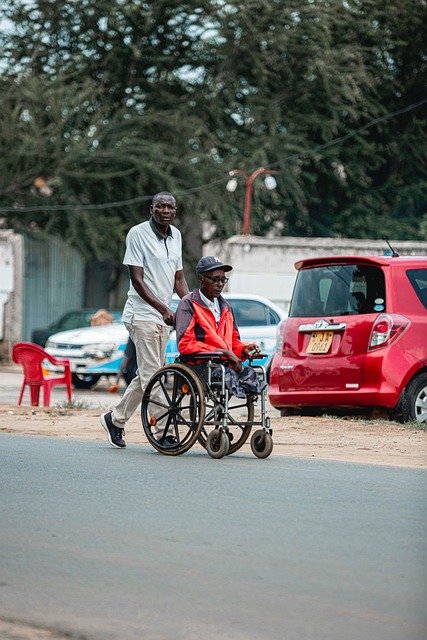Eugene, Oregon, is recognized for its comprehensive and accessible public transit system, offering an extensive network of buses, light rail, and paratransit services catering to diverse mobility needs. Dedicated facilities ensure independence for people with disabilities and seniors, while paratransit services provide door-to-door pick-up and drop-off, fostering community engagement. Despite progress, challenges remain, especially in suburban areas, calling for a multi-faceted approach to achieve inclusive transport goals.
“Exploring Accessible Transportation in Eugene, Oregon: A Comprehensive Guide
Eugene, known for its vibrant culture and lush landscapes, faces the challenge of enhancing public transit accessibility for its diverse community. This article delves into the current state of transportation for individuals with disabilities, seniors, and wheelchair users in Eugene. We examine the existing systems, usage statistics, and navigate the challenges, from topographical barriers to hub accessibility. Furthermore, it explores global best practices, highlighting innovative technologies and community initiatives. With a focus on inclusive transport, we propose strategies to shape Eugene’s future, ensuring everyone can conveniently navigate this beautiful city.”
- Current State of Public Transit Accessibility in Eugene Oregon
- – Overview of existing public transportation systems
- – Statistics on usage by disabled, senior citizens and individuals with wheelchairs
- Challenges Facing Accessible Transportation in Eugene Oregon
Current State of Public Transit Accessibility in Eugene Oregon

Eugene, Oregon, boasts a robust public transit system that prioritizes accessibility for all residents and visitors, including those with disabilities and seniors. The current state of accessible transportation in Eugene is characterized by an extensive network of buses, light rail, and paratransit services designed to cater to diverse mobility needs. These options ensure that wheelchair users, individuals with visual or cognitive impairments, and those who cannot use traditional bus services can navigate the city independently.
The city’s commitment to inclusive transport is evident through dedicated facilities like wheelchair-accessible stations, low-floor buses, and specialized paratransit vehicles. Paratransit services in Eugene Oregon offer door-to-door pick-up and drop-off, making it easier for those with limited mobility to access public transit. This comprehensive approach not only promotes independence but also fosters community engagement by enabling everyone, regardless of their abilities, to participate fully in urban life.
– Overview of existing public transportation systems

Eugene, Oregon boasts an extensive public transportation system designed to be accessible transportation for all residents and visitors. The network includes buses, light rail, and paratransit services, ensuring inclusive transport throughout the city. These various modes of transit are equipped with features like wheelchair ramps, low-floor entrances, and dedicated seating to cater to individuals with disabilities, including those using disabled transport.
The city’s commitment to senior transport is evident through its well-designed paratransit services, offering door-to-door pickup and drop-off for seniors and individuals with disabilities who cannot use regular bus service. This focus on wheelchair accessible Eugene Oregon and paratransit services Eugene Oregon ensures that everyone, regardless of their mobility, can navigate the city easily and independently.
– Statistics on usage by disabled, senior citizens and individuals with wheelchairs

In Eugene, Oregon, efforts to provide accessible transportation have significantly improved accessibility for individuals with disabilities, senior citizens, and those using wheelchairs. According to recent studies, public transit usage among these communities is steadily rising, reflecting a growing demand for inclusive transport. The local paratransit services, designed specifically to cater to the needs of the disabled, have seen an increase in riders, indicating a positive shift towards more accessible wheelchair accessible Eugene Oregon options.
Senior citizens, many of whom may face mobility challenges, also rely heavily on these services. Data shows that elderly residents increasingly opt for public transit as a convenient and efficient way to navigate the city. This trend underscores the success of Eugene’s commitment to providing senior transport solutions that promote independence and ease of movement within the community, ensuring everyone can participate fully in urban life.
Challenges Facing Accessible Transportation in Eugene Oregon

Eugene, Oregon, boasts an extensive public transit system, but ensuring accessible transportation remains a challenge for the city’s diverse community. Despite efforts to improve wheelchair accessible options, many residents with disabilities still face obstacles when relying on public buses and trains. The primary issues include limited paratransit services, especially in suburban areas, making it difficult for those with mobility impairments to navigate beyond the standard route network. Additionally, the current fleet lacks sufficient low-floor buses and specialized equipment, hindering easy access for seniors and individuals using wheelchairs or crutches.
The city’s inclusive transport goals are hindered by a lack of dedicated funding and awareness among transportation providers. Many elderly residents and people with disabilities either choose to drive or rely on informal carpooling options due to these accessibility barriers. Improving disabled transport in Eugene requires a multi-faceted approach, including investing in accessible vehicles, expanding paratransit coverage, and promoting public awareness about existing services to create a more inclusive transportation ecosystem for all residents of Eugene Oregon.
